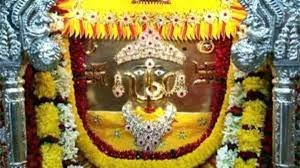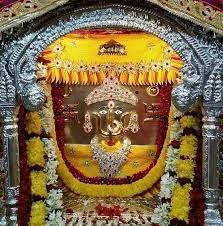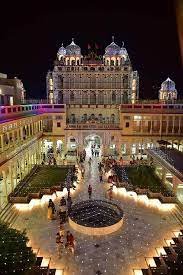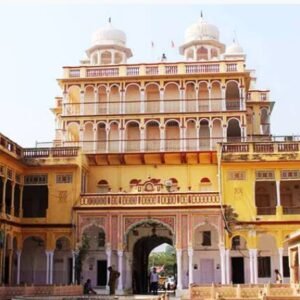Rani Sati Temple, Jhunjhunu
Even today, people of Rajasthan narrate the story of Rani Sati, also known as Dadi Ji, with immense pride and devotion. The Rani Sati Temple, located in the Jhunjhunu district of Rajasthan, is dedicated to her heroism and bravery. One of the characters in the Hindu mythological epic, Mahabharata, Rani Sati committed self-immolation after her husband’s death, thus proving her unflinching devotion to him. The temple is built from pure white marble and graced by the presence of exquisite paintings. A notable feature of the temple is the absence of any statues, of either male or female gods. Instead, the sanctum sanctorum houses a trident, which symbolises power, vigor, strength and bravery. There are other smaller temples dedicated to Lord Hanuman, Lord Shiva and Lord Ganesha, along with 12 smaller sati temples. An aarti is performed at the temple twice a day, once in the morning and once in the evening.
Rani Sati Temple (राणी सती दादी मंदिर) is a temple located in Jhunjhunu, Jhunjhunu district, in the state of Rajasthan, India. It is the largest temple in India devoted to Rani Sati, a Rajasthani lady who lived sometime between the 13th and the 17th century and committed sati (self-immolation) on her husband’s death. Various temples in Rajasthan and elsewhere are devoted to her worship and to commemorate her act. Rani Sati is also called Narayani Devi and referred to as Dadiji (grandmother).
The story of Rani Sati Dadi Maa starts from the time of Mahabharata. When Abhimanyu died in the battle of Mahabharat,Uttara (Narayani in Kaliyug) was shocked and angry to see Abhimanyu (Tandhan in Kaliyug) lost his life in the act of betrayal by Kauravas.So Uttara wants to end her life as an act of honour and to make Kauravas aware of their misdeed. But at the time of giving her life Uttara was about to give life to a child.Shree Krishna seeing this, told Uttara to forget about the idea of ending her life, as this is against Dharma of a Woman who is just about to give a life to a child. Realising the mistake, Uttara requested Shree Krishna to be married to Abhimanyu and her desire to be sati in her next life.
As granted by Lord Krishna, in her next life she was born as the daughter of Gursamal Birmewal in the village of Dokwa in Rajasthan and was named Narayani. Abhimanyu was born in Hissar as a son of Jaliram Jalan and named Tandhan Jalan. Tandan and Narayani got married and were leading a peaceful life. He was in possession of a beautiful horse which was being eyed by the son of king of Hissar for quite some time. Tandhan refused to hand over his precious horse to the king’s son.
The king’s son then decides to forcefully acquire the horse and thus challenges Tandan to a duel. Tandan fights the battle bravely and kills the king’s son. The enraged king thus kills Tandan in front of Narayani in the battle. Narayani, symbolic of female bravery and power, fights with the king and kills him. She then commanded Ranaji (the caretaker of the horse) to make immediate arrangements for her to be set ablaze along with her husband’s cremation.
Ranaji, playing a vital role in fulfilling her wish to be sati with her husband, is then blessed by Narayani that his name will be taken and worshiped along with her name and since then she is known as Rani Sati.The temple is notable for not holding any paintings or statues of either female or male gods. Instead a trishul depicting power and force is worshipped religiously by the followers. A portrait of Rani Sati dadiji is locate in the pradhan mand. The temple constructed from white marble and has colorful wall paintings.
Hundreds of devotees visit the temple every day. An elaborate aarti is performed at the temple two times a day.
• Mangala Aarti: performed in the early morning, when the temple is opened.
• Sandhya Aarti: performed in the evening, at sunset.
A special Poojan utsav is held on the occasion of Bhadra Amavasya: The 15th day of the dark half of Bhadra month in the Hindu calendar is of special significance to the temple
In the complex of Rani Sati temple there is also the Lord Hanuman Temple, Sita Temple, Thakur Ji temple, Lord Ganesha Temple and Shiva Temple. A regular ‘Prasad’ distribution takes place after every ‘aarti’ As well as the main temple there are twelve smaller sati temples A huge statue of Lord Shiva is located in the centre of the complex and is surrounded by green gardens.Inside the temple, the interiors are adorned with exquisite murals and glass mosaics depicting the entire history of the place.













